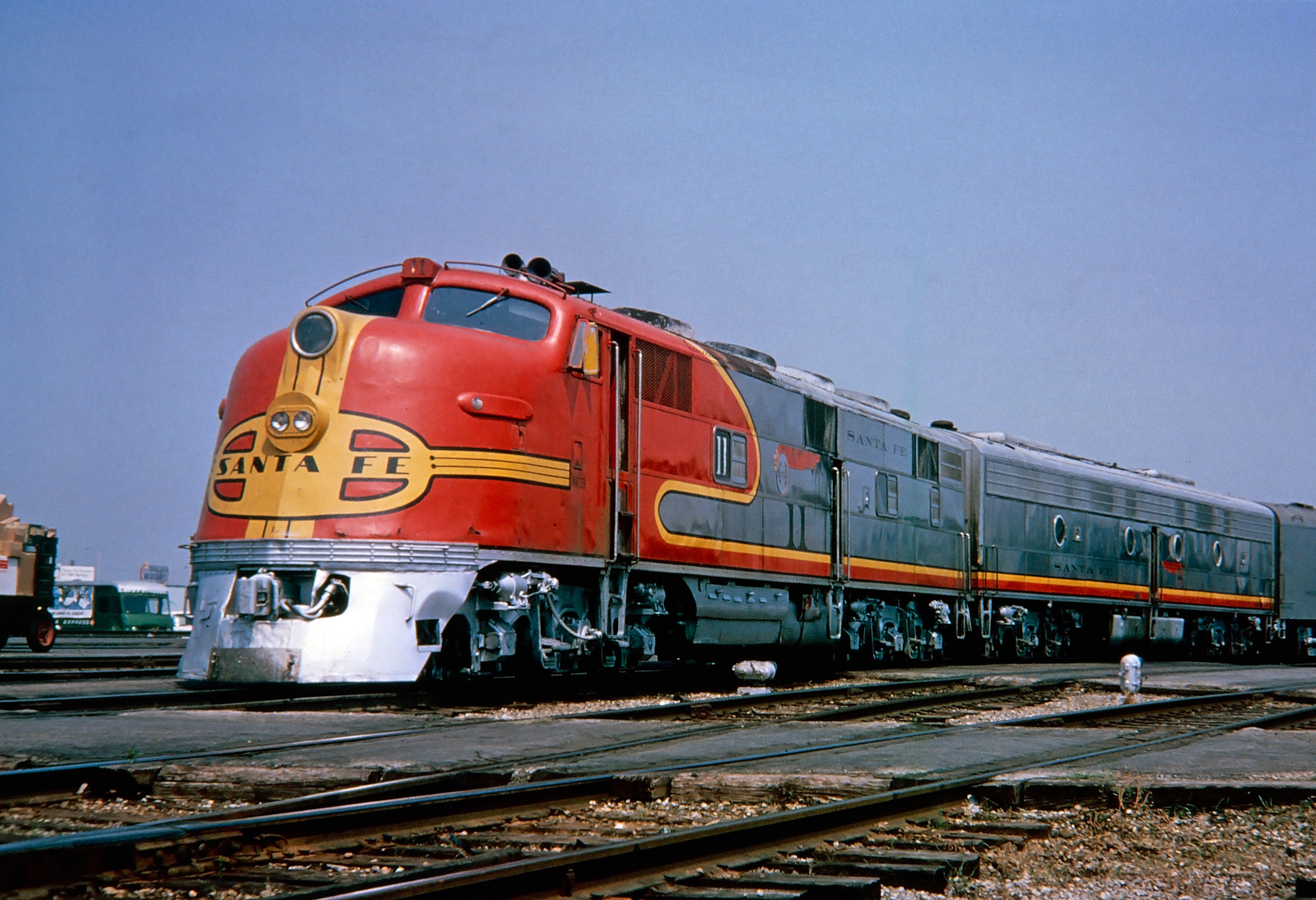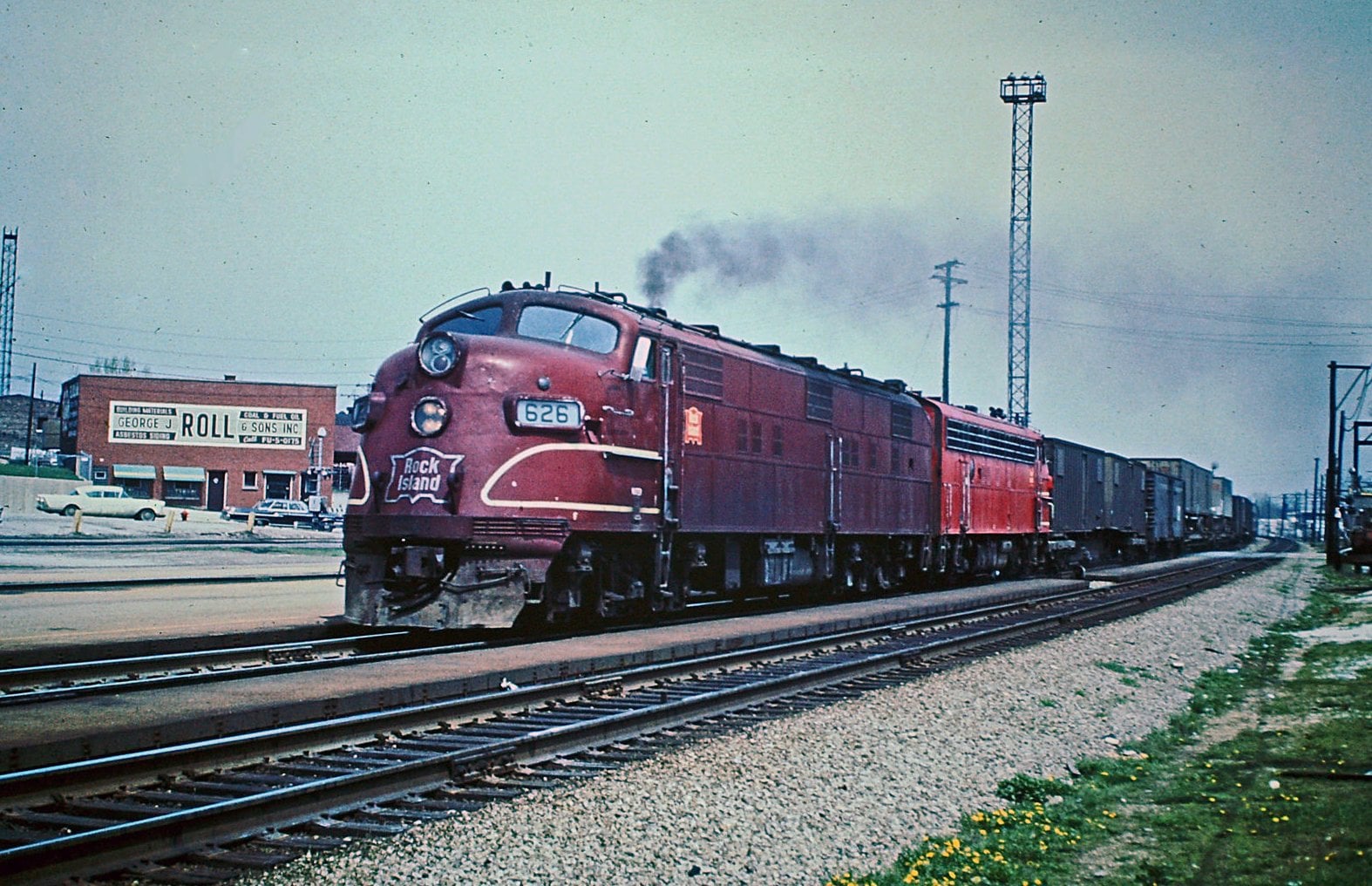EMC "E3" Locomotives: Data, Specs, Roster
Last revised: August 27, 2024
By: Adam Burns
The E3 was the third generation cab design Electro-Motive produced, intended for use in passenger service. It was also one of the last models EMC manufactured before becoming an official division of General Motors.
The E3 was different from the earlier three models and three distinct ways:
- Firstly, it used a new prime mover developed by General Motors and not the troublesome 201-A model from the Winton Engine Company.
- Secondly, it could produce greater horsepower.
- Thirdly, it was the first model cataloged to the general industry (the EA, E1, and E2 were basically "experimental" designs tested and purchased by the Baltimore & Ohio, Santa Fe, and Union Pacific).
Today, one example of the model survives, Atlantic Coast Line E3A #501. The locomotive is restored back into its original ACL passenger livery (purple and silver) and on display at the North Carolina Transportation Museum, in Spencer (usually tucked away in the roundhouse).
Photos
 Santa Fe's only E3A, #11-L, awaits departure from Dallas Union Station, circa 1960. Mac Owen photo. The unit, acquired in 1939, remained in service for nearly 30 years. She was finally retired on June 28, 1968. American-Rails.com collection.
Santa Fe's only E3A, #11-L, awaits departure from Dallas Union Station, circa 1960. Mac Owen photo. The unit, acquired in 1939, remained in service for nearly 30 years. She was finally retired on June 28, 1968. American-Rails.com collection.Overview
The E3 began production in March, 1939 as the builder's third passenger diesel model. As mentioned above it was Electro-Motive's first to feature a GM prime mover, in this case the model 567, featuring two engines. With each 567 able to produce 1,000 horsepower, the E3 was rated at 2,000 horsepower.
As with the EA, E1, and E2, the E3 featured an A1A-A1A truck setup (three axles per truck whereby the center axle was unpowered) and using GM's original model D7 traction motor it could produce around 31,000 pounds of continuous tractive effort (and 56,500 pounds of starting effort).
Not exactly an impressive number for a main line locomotive but then again it was powering only passenger service and not heavy freight trains up steep grades.
Once again, the E3 was very long (much longer its freight counterpart, the FT) at 71-feet, weighing 157.5 tons (the accompanying B unit weighed in at 145 tons).
However, Electro-Motived updated the carbody from earlier models. The E3 featured more straightforward streamlining with a long, sloped, "slant nose" that became closer to the classic trademark of later models it built under the EMD banner, beginning with the FT and used on every subsequent freight and passenger model.
This slant nose replaced the original "shovel nose" EA model, termed such as its front nose featured a slightly more raked design without the addition of a protruding, center headlight.
 An aging Rock Island E3A (built in 1939) has the "Cornhusker" at Blue Island, Illinois in 1967. The train appears to consist largely of mail/express and intermodal business. Note the New York Central "Flexi-Van" car directly behind the locomotives.
An aging Rock Island E3A (built in 1939) has the "Cornhusker" at Blue Island, Illinois in 1967. The train appears to consist largely of mail/express and intermodal business. Note the New York Central "Flexi-Van" car directly behind the locomotives.Unfortunately, the E3 was a rather unsuccessful model, partly because railroads were not yet sold on diesels as a main line locomotive (that would come with the aforementioned FT, which began demonstrations in 1939).
While just seventeen E3s were built, eight Class I railroads did purchase at least one with the Chicago & North Western owning the most (four).
The Santa Fe and Union Pacific also purchasing one cabless, booster (B) unit each. Other lines to purchase the locomotive included UP (an A-B set), ACL (2), Santa Fe (an A-B set), Rock Island (2), Florida East Coast (2), Kansas City Southern (2), and Missouri Pacific (2). Additionally, EMC's one demonstrator, #822 was eventually sold to the KCS and listed as #1 by the railroad.
Data Sheet and Specifications
| Entered Production | 9/1938 (Demonstrator #822) |
| Years Produced | 9/1938 - 6/1940 |
| Engine | 567 (2) |
| Engine Builder | GM |
| Horsepower | 2000 |
| RPM | 800 |
| Cylinders | 12 |
| Length | 71' 1 ¼" |
| Height (Top Of Rail To Top Of Cab) | 13' 11" |
| Height (Top Of Rail To Top Of Roof Horn) | 14' 0" |
| Width | 10' 7" |
| Weight | 315,000 Lbs (A Units): 290,000 Lbs (B Units) |
| Fuel Capacity | 1,200 Gallons |
| Air Compressor | Gardner-Denver |
| Air Compressor Model | WBO |
| Air Brake Manufacturer | Westinghouse |
| Air Brake Schedule | HSC |
| Trucks | A1A |
| Truck Type | Blomberg |
| Truck Wheelbase | 14' 1" |
| Wheel Size | 36" |
| Steam Generator Manufacturer | Vapor-Clarkson |
| Steam Generator Capacity | 1200 Lbs/Hr |
| Traction Motors | D7 (4), GM |
| Primary Generator | D4 (2), GM |
| Auxiliary Generator | Delco |
| MU (Multiple-Unit) | Yes |
| Dynamic Brakes | No |
| Gear Ratio | 52:15 |
| Tractive Effort (Starting) | 56,500 Lbs at 25% |
| Tractive Effort (Continuous) | 31,000 Lbs at 11 mph |
| Top Speed | 116 mph |
Production Roster
E3A
Total Built = 17
| Owner | Road Number | Serial Number | Order Number | Completion Date | Quantity |
|---|---|---|---|---|---|
| Electro-Motive (Demonstrator) | 822* | 822 | E254 | 9/1938 | 1 |
| Union Pacific | LA5 | 893 | E225 | 3/1939 | 1 |
| Chicago & North Western | 5001A-5002A, 5001B-5002B | 930-933 | E246 | 5/1939-6/1939 | 4 |
| Chicago, Rock Island & Pacific | 625-626 | 934-935 | E245 | 7/1939 | 2 |
| Missouri Pacific | 7000 | 936 | E252 | 10/1939 | 1 |
| Missouri Pacific | 7001 | 937 | E253 | 10/1939 | 1 |
| Kansas City Southern | 2 | 938 | E255 | 8/1939 | 1 |
| Atchison, Topeka & Santa Fe | 11 | 954 | E263 | 8/1939 | 1 |
| Florida East Coast | 1001-1002 | 956-957 | E266 | 11/1939 | 2 |
| Atlantic Coast Line | 501-502 | 958-959 | E267 | 11/1939 | 2 |
| Kansas City Southern | 3 | 1034 | E293 | 6/1940 | 1 |
* Became Kansas City Southern #1.
E3B
Total Built = 2
| Owner | Road Number | Serial Number | Order Number | Completion Date | Quantity |
|---|---|---|---|---|---|
| Union Pacific | LA6 | 894 | E226 | 3/1939 | 1 |
| Atchison, Topeka & Santa Fe | 11A | 955 | E264 | 9/1939 | 1 |
For the companies that did purchase the E3 they remained in use for a number of years before finally be bumped from service, most of the time due to EMD's newer models like the E7, E8, and E9 (the last ever offered). After the E3 was cataloged EMD continued to struggle with its passenger models, both the E4 and E5 also sold poorly.
However, beginning with the E6, which was offered just before the start of World War II, the builder finally found success thanks in no small part to successful marketing campaign of FT. As a result designs like the aforementioned E7, E8, and E9 proved very successful selling more than 1,000 examples combined.
Sources
- Foster, Gerald. A Field Guide To Trains. New York: Houghton Mifflin, 1996.
- Hayden, Bob. Diesel Locomotives: Cyclopedia, Volume 2 (Model Railroader). Milwaukee: Kalmbach Publishing Company, 1980.
- Marre, Louis A. Diesel Locomotives: The First 50 Years, A Guide To Diesels Built Before 1972. Milwaukee: Kalmbach Publishing Company, 1995.
- Pinkepank, Jerry A. Diesel Spotter's Guide. Milwaukee: Kalmbach Publishing Company, 1967.
- Solomon, Brian. EMD Locomotives. Minneapolis: MBI Publishing Company, 2006.
Recent Articles
-
New Jersey's 'Wine Tasting' Train Rides
Dec 13, 25 11:26 PM
If you're seeking a unique outing or a memorable way to celebrate a special occasion, wine tasting train rides in New Jersey offer an experience unlike any other. -
New Hampshire's 'Wine Tasting' Train Rides
Dec 13, 25 11:18 PM
This article details New Hampshire's most enchanting wine tasting trains, where every sip is paired with breathtaking views and a touch of adventure. -
New York - Murder Mystery - Dinner Train Rides
Dec 13, 25 10:30 AM
New York State, renowned for its vibrant cities and verdant countryside, offers a plethora of activities for locals and tourists alike, including murder mystery train rides!



